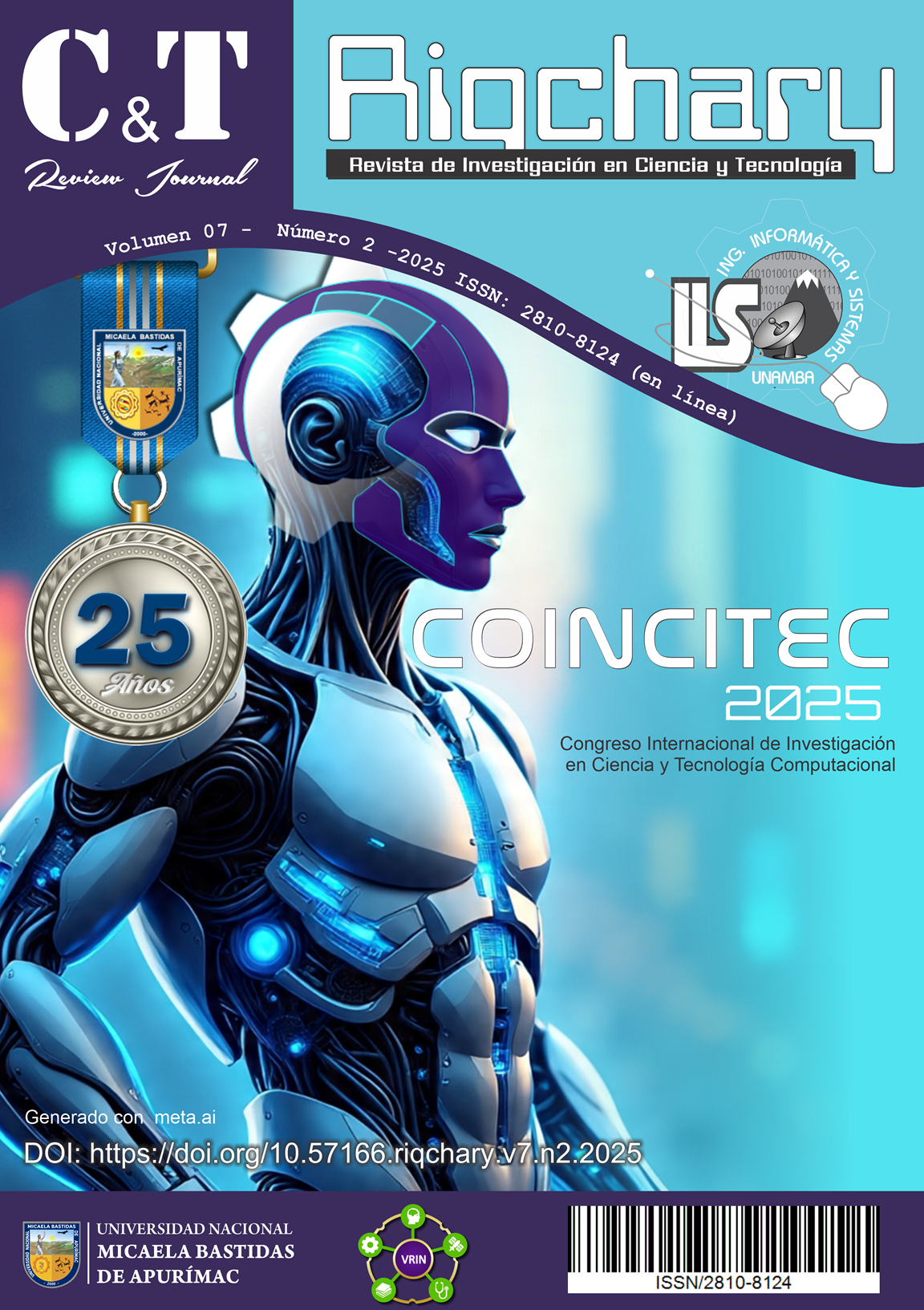Detección de conjuntivitis a partir de imágenes oculares utilizando arquitecturas CNN y un modelo de fusión
Contenido principal del artículo
Resumen
La conjuntivitis es una causa frecuente de consulta oftalmológica y puede generar complicaciones graves si no se detecta a tiempo. Este estudio evalúa tres arquitecturas de redes neuronales convolucionales preentrenadas —EfficientNetB0, InceptionV3 y ResNet50— para la clasificación automática de imágenes oculares con y sin signos de conjuntivitis. Además, se propone un modelo de fusión que combina las salidas intermedias de InceptionV3 y ResNet50. Todos los modelos fueron entrenados usando aceleración por GPU y técnicas de regularización y aumento de datos. InceptionV3 obtuvo el mejor desempeño general, con una exactitud del 95.00 % y una precisión de 0.98 para la clase positiva y 0.92 para la clase negativa, mostrando un balance sólido entre sensibilidad y especificidad. EfficientNetB0 destacó por alcanzar el mayor recall en la clase positiva y la menor tasa de falsos negativos, aunque con una precisión considerablemente menor. ResNet50 presentó la menor tasa de falsos positivos, siendo útil para reducir diagnósticos erróneos en casos negativos. El modelo de fusión alcanzó métricas competitivas y un tiempo de entrenamiento reducido, demostrando que la integración de arquitecturas puede aumentar la robustez del sistema. Este trabajo ofrece una guía práctica y reproducible para la selección de modelos en el diagnóstico automatizado de conjuntivitis, especialmente útil en contextos con recursos médicos limitados.
Detalles del artículo

Esta obra está bajo una licencia internacional Creative Commons Atribución-NoComercial-SinDerivadas 4.0.
Cuando un autor crea un artículo y lo publica en una revista, los derechos de autor pasan a la revista como parte del acuerdo de publicación. Por lo tanto, la revista se convierte en la dueña de los derechos de reproducción, distribución y venta del artículo. El autor conserva algunos derechos, como el derecho a ser reconocido como el creador del artículo y el derecho a utilizarlo para sus propios fines académicos o de investigación, a menos que se acuerde lo contrario en el contrato de publicación.
Cómo citar
Referencias
A. Y. Cheung, D. S. Choi, S. Ahmad, G. Amescua, V. Jhanji, A. Lin, S. I. Mian, M. K. Rhee, E. T. Viri-ya, F. S. Mah y D. M. Varu; American Academy of Ophthalmology Preferred Practice Pattern Cor-nea/External Disease Panel, “Conjunctivitis Pre-ferred Practice Pattern,” Ophthalmology, vol. 131, no. 4, pp. P134–P204, Apr. 2024. doi:10.1016/j.ophtha.2023.12.037.
M. Teweldemedhin, H. Gebreyesus, A. H. Atsbaha, S. W. Asgedom, and M. Saravanan, “Bacterial profile of ocular infections: A systematic review,” BMC Ophthalmol., vol. 17, no. 1, pp. 1–9, 2017, doi: 10.1186/s12886-017-0612-2.
D. S. W. Ting, C. Y. Cheung, G. Lim, N. M. Hsu, W. H. Tan, et al., “Development and Validation of a Deep Learning System for Diabetic Retinopathy and Related Eye Diseases Using Retinal Images From Multiethnic Populations With Diabetes,” JAMA, vol. 318, no. 22, pp. 2211–2223, Dec. 2017, doi:10.1001/jama.2017.18152.
S. Mondal, S. Banerjee, S. Mukherjee, A. Ganguly, and D. Sengupta, “Deep Classifier for Conjunctivitis – A Three-Fold Binary Approach,” Int. J. Math. Sci. Comput., vol. 8, no. 2, pp. 46–54, 2022, doi: 10.5815/ijmsc.2022.02.05.
V. Gulshan, L. Peng, M. Coram, M. C. Stumpe, D. Wu, A. Narayanaswamy, et al., “Development and Validation of a Deep Learning Algorithm for Detection of Diabetic Retinopathy in Retinal Fundus Photographs,” JAMA, vol. 316, no. 22, pp. 2402–2410, Dec. 2016, doi:10.1001/jama.2016.17216.
S. Saha, S. K. Saha, S. Mukherjee, and S. Banerjee, “Deep learning for automated detection and classification of infectious conjunctivitis using slit-lamp images,” British Journal of Ophthalmology, Published Online First: 28 Mar. 2024, doi:10.1136/bjo-2023-324310
C. Y. Gamage, “NEURAL NETWORKS FOR CLASSIFICATION OF EYE CONJUNCTIVITIS IN TELEHEALTH : A CONCEPTUAL ARCHITECTURE,” vol. 6, no. 2, pp. 172–182, 2024.
F. Rashid, J. Abate, and A. Abdi, “Multiclass Classification and Identification of the External Eye Diseases using Deep CNN,” Indian J. Sci. Technol., vol. 17, no. 12, pp. 1107–1116, 2024, doi: 10.17485/ijst/v17i12.21.
R. K. Bawa and A. Koul, “Automated detection of conjunctivitis using convolutional neural network,” Appl. Data Sci. Smart Syst., pp. 91–97, 2024, doi: 10.1201/9781003471059-13.
C. J. Mann, “Observational research methods. Research design II: cohort, cross sectional, and case-control studies,” Emergency Medicine Journal, vol. 20, no. 1, pp. 54–60, Jan. 2003, doi:10.1136/emj.20.1.54.
H. Kaur and N. K. Sandhu, “International Journal of Communication Networks and Information Security Evaluating the Effectiveness of the Proposed System Using F1 Score , Recall , Accuracy , Precision and Loss Metrics Compared to Prior Techniques,” vol. 15, no. 04, pp. 368–383, 2023.
A. Géron, Hands-On Machine Learning with Scikit-Learn, Keras, and TensorFlow, 3rd ed., Sebastopol, CA, USA: O’Reilly Media, 2022. ISBN: 978-1-098-18109-1.
D. Callaghan, J. Burger, and A. K. Mishra, “A machine learning approach to radar sea clutter suppression,” 2017 IEEE Radar Conf. RadarConf 2017, pp. 1222–1227, 2017, doi: 10.1109/RADAR.2017.7944391.
G. Research, “What is Colaboratory?” [Online]. Available: https://research.google.com/colaboratory/faq.html
K. He, X. Zhang, S. Ren, and J. Sun, “Deep residual learning for image recognition,” Proc. IEEE Comput. Soc. Conf. Comput. Vis. Pattern Recognit., vol. 2016-Decem, pp. 770–778, 2016, doi: 10.1109/CVPR.2016.90.
M. Tan and Q. V. Le, “EfficientNet: Rethinking model scaling for convolutional neural networks,” 36th Int. Conf. Mach. Learn. ICML 2019, vol. 2019-June, pp. 10691–10700, 2019.
C. Szegedy, V. Vanhoucke, S. Ioffe, J. Shlens, and Z. Wojna, “Rethinking the Inception Architecture for Computer Vision,” Proc. IEEE Comput. Soc. Conf. Comput. Vis. Pattern Recognit., vol. 2016-Decem, pp. 2818–2826, 2016, doi: 10.1109/CVPR.2016.308.
S. Patel, R. Patel, N. Ganatra, and A. Patel, “Spatial Feature Fusion for Biomedical Image Classification based on Ensemble Deep CNN and Transfer Learning,” Int. J. Adv. Comput. Sci. Appl., vol. 13, no. 5, pp. 153–159, 2022, doi: 10.14569/IJACSA.2022.0130519.
C. Shorten and T. M. Khoshgoftaar, “A survey on Image Data Augmentation for Deep Learning,” Journal of Big Data, vol. 6, no. 60, pp. 1–48, 2019, doi:10.1186/s40537-019-0197-0.





